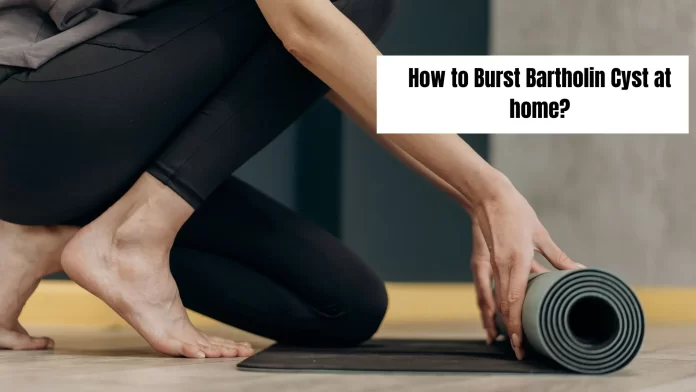It is important to note that attempting to burst a Bartholin cyst at home is not recommended. Bartholin cysts are fluid-filled sacs that develop near the opening of the vagina, usually as a result of a blockage of the Bartholin gland. While they can cause discomfort and pain, it is crucial to seek proper medical attention for diagnosis and treatment. In this article, we will explore how to burst a bartholin cyst at home, their symptoms, and the appropriate course of action to take for their management. Remember, it is always best to consult with a healthcare professional who can provide accurate guidance and personalised care.
Bartholin’s cyst
A Bartholin’s cyst is a lump filled with fluid that typically appears near the opening of the vagina. While it is usually not a serious condition, an infected Bartholin’s cyst can cause significant pain and discomfort.
Symptoms of a Bartholin’s cyst
In some cases, a Bartholin’s cyst can be small and painless, going unnoticed. In such instances, it may not require any intervention as it has the potential to open and drain on its own.
However, there are instances where the cyst can grow in size and cause discomfort. In such cases, symptoms of a larger Bartholin’s cyst become more apparent.
These symptoms may include:
- Tenderness in the vicinity of the vaginal opening
- Feeling of pressure at the vaginal opening
- Pain or discomfort during sexual intercourse
- Discomfort while sitting or walking
If the cyst becomes infected, you may observe the presence of pus. Additionally, if an infection occurs, you may experience a fever.
Causes of Bartholin’s cyst
Bartholin’s cysts develop when the ducts of the Bartholin’s glands, which are located on both sides of the vaginal opening, become obstructed. Normally, these glands are small, measuring no more than 1 cm in size.
The blockage of the duct leads to the accumulation of the fluid that is typically secreted to lubricate the vagina. As a result, the trapped fluid expands, forming a cyst.
The specific cause of a blocked duct is not always identifiable. However, potential factors that may contribute to the blockage include:
- Bacterial infections, such as Escherichia coli or sexually transmitted infections (STIs)
- Previous occurrence of a Bartholin’s cyst
- Trauma to the area
- Prior surgical procedures
Treatment Option
Here are some common treatment options:
Warm compress: Applying a warm compress to the affected area can help relieve discomfort and promote drainage of the cyst. This can be done by soaking a clean cloth in warm water and gently applying it to the cyst several times a day.
Sitz baths: Taking sitz baths, where you sit in warm water, can also aid in relieving symptoms and encouraging drainage. You can do this by filling a bathtub or basin with warm water and sitting in it for about 10-15 minutes, a few times a day.
Antibiotics: If the cyst is infected or causing severe symptoms, your healthcare provider may prescribe antibiotics to treat the infection and reduce inflammation. Completing the entire prescribed antibiotic course is crucial for effective treatment.
Incision and drainage: In some cases, if the cyst is large, persistent, or causing significant discomfort, a healthcare professional may recommend a minor surgical procedure called incision and drainage. This procedure involves making a small incision in the cyst to drain the fluid and alleviate symptoms.
Marsupialization: For recurrent or chronic Bartholin’s cysts, a surgical technique called marsupialization may be considered. This procedure involves creating a small incision and stitching the edges of the cyst wall to create a permanent opening, allowing continuous drainage.
How to burst a Bartholin cyst at home?
Taking sitz baths multiple times a day, where you immerse yourself in a tub filled with a few inches of warm water, can potentially assist in the natural rupture and drainage of a small, infected Bartholin’s cyst over the course of three or four days.
Summary
A Bartholin’s cyst is a fluid-filled lump near the vaginal opening that can become infected and cause discomfort. Treatment options for how to burst a bartholin cyst at home include warm compresses, sitz baths, antibiotics, incision and drainage, or marsupialization. Sitz baths may help small, infected cysts rupture and drain on their own. Seeking guidance from a healthcare professional is vital for accurate diagnosis and appropriate treatment.
FAQ
Q1: What are the symptoms of a Bartholin’s cyst?
Ans: Symptoms may include tenderness, pressure, pain during intercourse, and discomfort while sitting or walking.
Q2: Can a Bartholin’s cyst go away on its own?
Ans: Small, painless cysts may resolve without treatment, but larger or infected cysts may require intervention.
Q3: How is a Bartholin’s cyst diagnosed?
Ans: Diagnosis is typically made through physical examination and medical history assessment by a healthcare professional.
Q4: What is the treatment for an infected Bartholin’s cyst?
Ans: Treatment options include warm compresses, sitz baths, antibiotics, or in some cases, incision and drainage.






